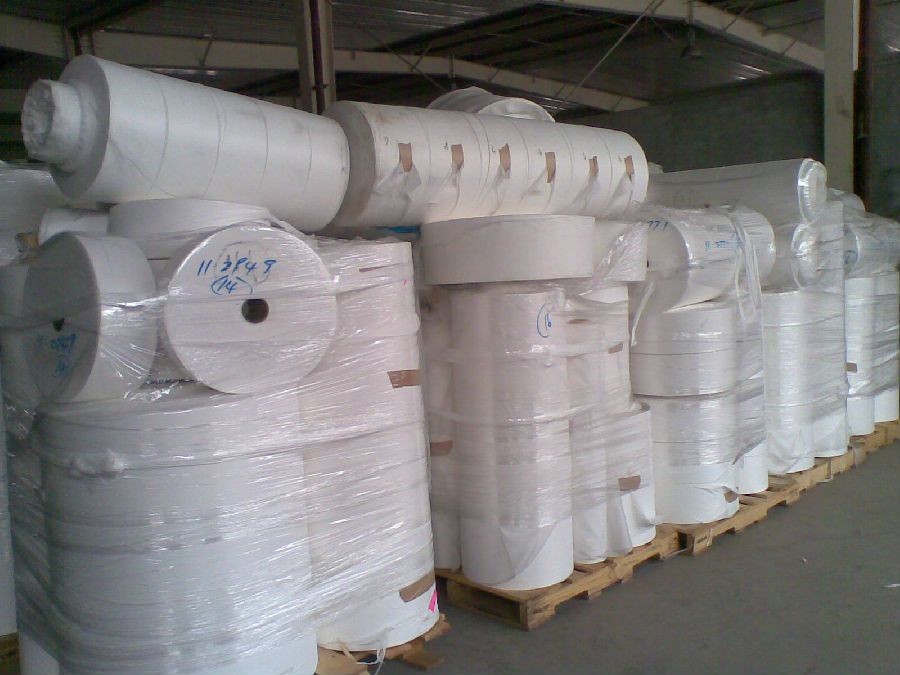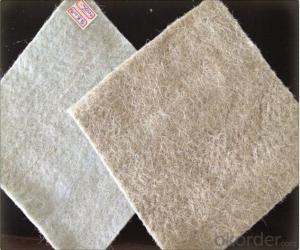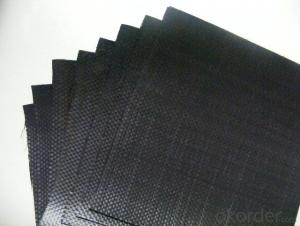Short Fiber Needle Punched Non Woven Geotextile Fabric Tubes
- Loading Port:
- Tianjin
- Payment Terms:
- TT OR LC
- Min Order Qty:
- 2000 m²
- Supply Capability:
- 900000 m²/month
OKorder Service Pledge
OKorder Financial Service
You Might Also Like
Product Description
Function :seperation,filtration,reinforcement,drainage
usage:seperation of different materials.
applied between subgrade and groundwork of the paved(unpaved)road or airport road.
applied between the subgrade and ballast of the railway,
applied in the landfill ground and gravel subgrade,
applied between the, geomembrane and sandy drainage layer
applied between the subgrade and groundwork to undertake the additional load.
applied between the earth of groundwork and foundation soil,
applied under footpath,parking lot,stadium,
applied between the now and old asphalt.
Reinforcement:applied on the soft foundation of the unpaved road, the airtport path,railroad,the landfill,
he stadium,etc. to prevent the geomembrane to be punctured by the gavel.
Filtration: applied at the bottom of the landfill that penetrate,to protect the geonet and geocomposite,and
prevent the soil to enter inside
Drainage: applied under the geomembrane,the stadium,the ballast of the railway.
Category: staple fibre needle punched non-woven geotextile, etc.

specifications
cItem | Area weight | Tensile Strength | Elongation | shrinkage | Roll Size | ||
MD | CMD | MD | CMD | ||||
Unit | G/M2 | N/125px | % | % | m x m | ||
Specification | 120 | ≥350 | ≥260 | 23 | 28 | <2.0< span=""> | 1.02x1700 |
140 | ≥380 | ≥300 | 25 | 30 | <1.0< span=""> | 1.01x1500 | |
150 | ≥500 | ≥330 | 28 | 35 | <1.0< span=""> | 1.01x1500 | |
160 | ≥550 | ≥350 | 30 | 35 | <1.0< span=""> | 1.01x1400 | |
180 | ≥600 | ≥450 | 30 | 35 | <1.0< span=""> | 1.01x1200 | |
200 | ≥750 | ≥450 | 30 | 35 | <1.0< span=""> | 1.01x1100 | |
220 | ≥800 | ≥500 | 30 | 35 | <1.0< span=""> | 1.01x1000 | |
250 | ≥950 | ≥600 | 35 | 40 | <1.0< span=""> | 1.01x800 | |
Packaging & Delivery
| Packaging Details: | general packing or according to customers' request |
| Delivery Detail: | 15 days after receiving T/T |

FAQ
Q: What kind of payments does jenor support?
A: T/T, L/C, Cash are accepted.
Q: Do you charge for the samples?
A: Accordeing to our company policy, the samples are freee, we only charge the freight fee. And we will return the freight fee during the next order.
Q: Can you produce according to customers' design?
A: Sure, we are professional manufacturer, OEM and ODM are both welcome.
Q: Do you have other products?
A: Yes, please contact us
- Q: What type of geotextile is used for soccer field
- Generally with permeable geotextile, 200g300g can be
- Q: Can geotextiles withstand harsh weather conditions?
- Yes, geotextiles are designed to withstand harsh weather conditions. They are made from durable materials that are resistant to UV radiation, moisture, and fluctuating temperatures. Geotextiles provide long-lasting protection and stability in various weather conditions, making them suitable for use in challenging environments.
- Q: Construction scheme of geotextile water filter
- Second, the design: program one: in strict accordance with the requirements of the national standard construction, 5-year warranty 1, in the smooth level of leveling the overall construction brushing JS waterproof latex or polyurethane waterproof coating, the thickness of the national standard 1 standard; Weak parts to do additional layer to strengthen; 2, do 20 ~ 30mm thick waterproof mortar protective layer, divided into two construction, layer waterproof layer of pulp interface; require nano-silicon waterproofing agent and expansion agent compound use. 3, backfill when asked not to smash the waterproof layer. 4, indoor ground practice ibid, the wall to do high 1m. Option 2: with reference to national standard requirements simple practice, the warranty period of 1 year 1, the overall construction of coated asbestos asphalt waterproof coating or waterproof cold primer, the thickness of the standard by the national standard 2; special weak parts to do additional layer to strengthen; Outside the protection, requiring the use of sticky or sticky sticky construction; 3, backfill when asked not to smash the waterproof layer. 4, indoor ground practice reference program one, the wall to do high 1m.
- Q: Do you want to use glue to connect the geotextile?
- Hello, geotextile is not glue to connect, with needle and thread stitching, the request is not too high, but also intestinal smooth spot heap stupid do not need to stitch, as long as take the lead, put up on it.
- Q: Geotextile special staple fiber where needed
- How much is a ton?
- Q: How can we file in the Water Resources Department? I was doing hydraulic works with geotextiles, geogrids, gabion, gabbin.
- Water geotechnical engineering geotextile, geogrid, gabion, Geben network should belong to the geotextile material series, you can refer to the required record of the Department of Water Resources on the geotechnical industry for the record requirements. At present, the provinces and cities of the record requirements are not the same, you want to record in which provinces and cities will go to the provincial and municipal water conservancy department official website to see the specific requirements, the Internet will generally have publicity, you can call the consultation. The general information required for the record includes: business license, tax registration certificate, organization code certificate, national industrial production license, safety production license, ISO9000 / ISO certification, legal personality certificate, power of attorney, contract copy in recent years Three-year financial audit report, the company's basic household certification.
- Q: Geotextile exports Nordic need certification
- Production standards geotextile, geomembrane, composite geomembrane. Certificate, test report
- Q: Geotextile now how much money? what is the price?
- Geotextile, also known as geotextile, it is made of synthetic fiber through acupuncture or woven from the permeability of geosynthetics. Geotextile is a new material geosynthetics which one, the finished product for the cloth, the general width of 4-6 meters, the length of 50-100 meters. Geotextile is divided into a spinning geotextile and non-woven filament geotextile. Geotextile price in addition to weight (80-1500g / ㎡) to count, the quality standard is also a requirement, divided into non-standard, whitening A, Sinochem, the general national standard, Paul GB, Dahua GB and so on. Ton price is generally between 4000-8000 yuan / ton geotextile material manufacturers to answer
- Q: Can geotextiles be used in reservoir lining projects?
- Yes, geotextiles can be used in reservoir lining projects. Geotextiles are commonly employed to improve the stability and performance of reservoir linings by providing reinforcement, filtration, and separation functions. They can effectively prevent soil erosion, control seepage, and enhance the overall integrity and longevity of the reservoir lining system.
- Q: JTGF80 / 1-2004 "standard" 4.5 Geosynthetics in the treatment of the measured items in the "anchoring length", in the construction design diagram, the provisions of the value of the allowable deviation should be how to implement? Question added: Sorry! I missed a few words. When the construction design is not indicated, the specified value, the allowable deviation value should be implemented? JTGF80 / 1-2004 "standard only write to meet the design, construction requirements. I did not say that the design of the length of the anchorage is how much, can not find the construction technical specifications. So I do not know the provisions of the value of how to allow deviation? More
- Specifically not less than the specified value, does not exceed the allowable deviation. This is the so-called construction by specification! You refer to JTG assessment standard -2004 is correct! I have the data to let you refer to the next / geogrid and geotextile landscape is greater than or equal to 50cm, vertical is greater than or equal to 150com
Send your message to us
Short Fiber Needle Punched Non Woven Geotextile Fabric Tubes
- Loading Port:
- Tianjin
- Payment Terms:
- TT OR LC
- Min Order Qty:
- 2000 m²
- Supply Capability:
- 900000 m²/month
OKorder Service Pledge
OKorder Financial Service
Similar products
Hot products
Hot Searches
Related keywords






























